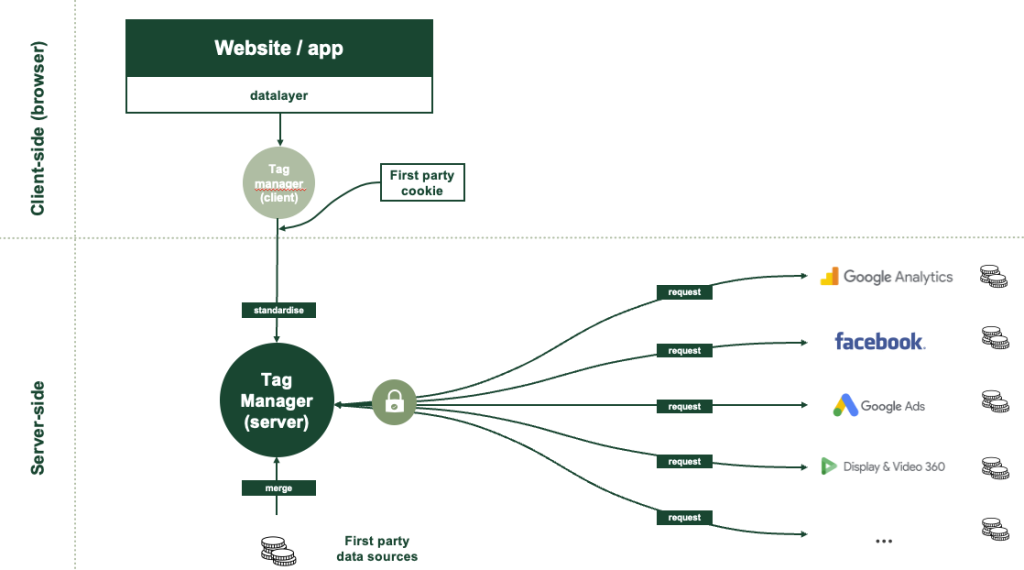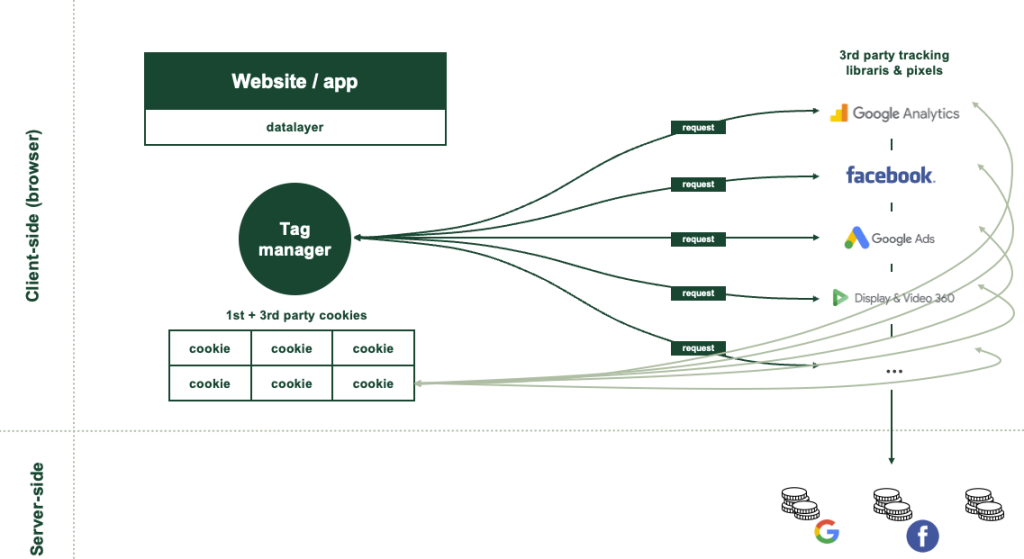Server-based monitoring – higher quality data and privacy
In the crossfire of third-party cookie erosion and the GDPR debate, many digital marketing professionals have been puzzled by the question: how will we continue to collect quality data in the future? An easy solution is to switch to server-based monitoring as quickly as possible. At the same time, privacy and the user experience of the site are improved. Dagmar Drive’s Junior Digital Solutions Specialist Tuukka Pallonen put together a concise briefing on server-based monitoring.
What is server-based monitoring?
Server-side tagging is based on technology enabled by Google Tag Manager. This is a feature of Tag Manager that can be used to create measurements, for example, using Google Cloud servers. All site visit data can be collected with a single tracking, the data of which is sent from the server to different systems.
Browser-based tracking:

Server-based monitoring:

Better privacy for analytics
The data collected in server-based tracking is first transferred to the site’s server, from where the data is forwarded to, for example, Google Analytics and advertising management systems.
In other words, data from the user’s browser and device is not sent directly to analytics, but the server can filter the data before transferring it to Google. The site owner can then control what data is tracked: for example, users’ IP addresses, which are considered personal data, may not be collected.
The tracking model also makes it possible to select the geographical location of the data, for example, to Finland or another EU area. This allows us to avoid data leaking to the US, which has been one of the features of Google Analytics that has been of most concern to DPAs. [1]
High-quality tracking in a cookieless world
For example, Safari, Firefox and Brave, whose users account for about 30% of web traffic, are already out of reach of analytics. In server-based tracking, data is collected using first-party cookies, so analytics are also obtained from browsers that block third-party cookies. In other words, analytics data is collected only from interactions that have taken place on the site, an individual user cannot be identified on the site or later in other channels.
Why do load times matter?
Each tag that works through the browser increases the amount of extra code on the site. When trackers are run through a server instead of the user’s browser, site loading times are speeded up and the user experience is greatly improved.
Load time has a direct impact on digital business and customer journeys: for example, bounce rate increases by 32% when page load time increases from one second to three. [1] Loading time is also a significant factor in search engine optimization, so upgrading your trackers to server-based will also improve your site’s search engine visibility.
Dagmar’s experts install server-based monitoring in cooperation with those responsible for site development. Changing the tracking model from browser to server does not change the operation of Google Analytics in any way, so analytics data is accumulated throughout the project. We are also happy to train you in the self-installation of new trackers, so that analytics can also be developed independently in the future.
Sources:
[2] Google/SOASTA Research, 2017.
WRITTEN BY
-
 The liberalisation of the gambling industry in Finland affects your marketing as wellAt the beginning of 2027, Finland will move to the licensing market for the provision…Read the blog
The liberalisation of the gambling industry in Finland affects your marketing as wellAt the beginning of 2027, Finland will move to the licensing market for the provision…Read the blog -
 Accessibility and SEO: Success Factors in the Digital WorldAccessibility is an increasingly critical part of a website’s functionality and user experience. Although accessibility…Read the blog
Accessibility and SEO: Success Factors in the Digital WorldAccessibility is an increasingly critical part of a website’s functionality and user experience. Although accessibility…Read the blog -
 Here’s an AI tool for you, good luck!Implementing AI requires much more than a decision to get a paid tool and a…Read the blog
Here’s an AI tool for you, good luck!Implementing AI requires much more than a decision to get a paid tool and a…Read the blog
More on topic
-
 LUMENE’s media mix was optimized by modeling salesDagmar helped LUMENE identify the factors affecting sales. Based on the information, the level of…See our work
LUMENE’s media mix was optimized by modeling salesDagmar helped LUMENE identify the factors affecting sales. Based on the information, the level of…See our work -
 Helen’s renewed brand’s first tactical campaign: The lowest CPA of the year generated 30% of the month’s salesWhen Helen‘s new “It’s Energy” brand concept was followed by the first tactical campaign based…See our work
Helen’s renewed brand’s first tactical campaign: The lowest CPA of the year generated 30% of the month’s salesWhen Helen‘s new “It’s Energy” brand concept was followed by the first tactical campaign based…See our work -
 Satisfaction with the immediate results of marketing is an optical illusionAdvertising is the best business case when it generates cash flow both tomorrow and for…Read the blog
Satisfaction with the immediate results of marketing is an optical illusionAdvertising is the best business case when it generates cash flow both tomorrow and for…Read the blog